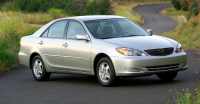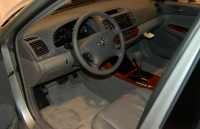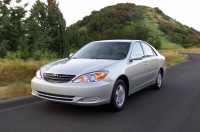Encountered on the roads sedans Toyota Camry 2003 model year are equipped with gasoline engines, working in conjunction with a manual or automatic transmission. Cars are distinguished by a spacious interior with soft furnishings, and the main units have a resource before overhaul in the range of 500-600 thousand km.
Description of the Toyota Camry 2003
The car belongs to the XV30 generation, which debuted in mid-2001. The cars were actively supplied to the North American market. Regardless of the market, only one body was used, which differed by trim elements and lighting (in accordance with regional regulations).
Exterior data: design  The car had a streamlined body with large headlamps (for the configuration of the diffusers generation XV30 received the nickname "dragonfly"). Increased angle of slope of the windshield and recessed in the sides doors allowed to reduce the coefficient of aerodynamic drag. The bumpers were made of impact-resistant plastic painted in the same color as the body. The luggage compartment had a hinged lid, the spare tire was stored in a special recess, closed by a hinged panel.
The car had a streamlined body with large headlamps (for the configuration of the diffusers generation XV30 received the nickname "dragonfly"). Increased angle of slope of the windshield and recessed in the sides doors allowed to reduce the coefficient of aerodynamic drag. The bumpers were made of impact-resistant plastic painted in the same color as the body. The luggage compartment had a hinged lid, the spare tire was stored in a special recess, closed by a hinged panel.
Advantages
The main advantages of the car:
large interior and trunk capacity;
rich complete set;
ease of repair and maintenance;
availability of spare parts (both new and dismantled from wrecked cars);
reliability of the power plant and suspension.
Car modifications  The following modifications were available on the market for the 2003 model year:
The following modifications were available on the market for the 2003 model year:
GLS, equipped with a 2.4-liter engine. The car had plastic exterior parts, painted in the main color of the body. Light-alloy wheels R16 were included to the basic equipment. Interior trim was in velour, fabric inserts on door panels and an armrest between the front seats with a recess for small items.
The CDX could be equipped with either a 2.4 or 3 liter engine. The interior leather trim was used, and a CD player was installed by default in all Camrys. Bumpers were equipped with ultrasonic parking sensors, and the screen of radio displays distance to obstacles.
Technical Specifications
Toyota Camry sedan 2003 model year is a classic representative of cars aimed at the American market. Large interior capacity and soft suspension allowed to move on smooth and straight roads, but the technique is not designed for sharp maneuvering. The fuel tank has a capacity of 65 to 70 liters, enough fuel reserves for highway driving up to 700-800 km.
When operating in the city or towing a trailer, gasoline consumption increases, which leads to a drop in range to 500-550 km/h.
Basic parameters
The car was equipped with a monocoque body, the power unit and suspension subframes were attached to the box spars. Alloyed steel elements were used to increase safety in front or side crashes. The windshield and rear window were glued into the openings and absorbed part of the load. The on-board power supply was 12 volts, the battery was in the engine compartment, the alternator with automatic regulator was mounted on the cylinder block and had a belt drive from the crankshaft.
Engine
In 2003 the trucks were equipped with the following engines:
The base 4-cylinder 1AZ-FE 2L and 144 hp;
152-horsepower in-line 2AZ-FE (4 cylinders, 2.4 liters);
V-twin 6-cylinder 1MZ-FE, 210 hp.  All engines have forced liquid cooling and electronic fuel management system. The exhaust manifold had a catalytic converter, which reduced the toxicity of gases to Euro-3 standards. The camshafts in the block heads were chain-driven, with four valves per cylinder.
All engines have forced liquid cooling and electronic fuel management system. The exhaust manifold had a catalytic converter, which reduced the toxicity of gases to Euro-3 standards. The camshafts in the block heads were chain-driven, with four valves per cylinder.
Beginning in 2003, the 1MZ-FE engine received the VVT-i variable valve timing system, which improved power and stabilized the torque curve.
Transmission
Transmissions installed on the trucks were:
5-speed synchromesh with manual control (was limited available in some markets with the 2-liter engine);
4-speed automatic with torque converter, used with 2.4 and 3 liter engines.
Left-hand drive version had front-wheel drive. There was an electronic system to reduce slippage when starting on slippery surfaces. The Four all-wheel drive transmission was used on some Japanese trucks. The gearbox was located inside the subframe of the rear suspension, due to the use of a cardan shaft, the fuel tank had a notch, which reduced the capacity by 5 liters.
Dimensions
Vehicle dimensions (according to the manufacturer):
wheelbase - 2720 mm;
body length - 4805 mm;
width with removed mirrors - 1795 mm;
height - 1470 mm;
ground clearance - 150 mm (could be reduced with installation of additional protection of the engine tray).
Suspension
The chassis consisted of an independent front suspension with lower arms and McPherson struts. At the rear was a 3-arm design with a shock absorber strut. Suspension components were mounted on the truck through welded subframes, which increased rigidity. In the front and rear anti-roll bars were used.
Brake system
The trucks are equipped by default with disc brakes for all wheels (ventilated units are applied at the front). The pads are hydraulically actuated, divided into two independent circuits. The circuit used vacuum booster, lever-operated parking brake actuated on the rear wheels.
Safety
Safety systems included:
front airbags;
airbags in the doors;
ABS system in the brake actuator;
3-point seat belts for driver and passengers.
Interior equipment
The cars were equipped with velour or leather trimmed interiors, and standard equipment included electric windshields in the doors and mirrors. The instrument cluster had a screen for displaying electronic odometer and trip computer data.
The instrument cluster had a screen for displaying electronic odometer and trip computer data.
The front seats were manually adjustable, the more expensive versions used electric actuators. An air conditioning system with a removable filter was standard equipment. The rear sofa had a folding back and a folding armrest with sockets for bottle tops.
Performance characteristics
Main parameters (modification with 2,4 liters engine with front-wheel drive):
cabin capacity - 5 people;
curb weight - 1390 kg;
allowable full weight - 1935 kg;
weight of a trailer (with brakes) - up to 1500 kg;
maximum speed - 200 km/h;
acceleration time from a place up to 100 km/h - 10,5 seconds;
capacity of luggage compartment - 520 l;
standard tire size - 205/60R16;
fuel type - gasoline A-95;
fuel consumption in the city - 11.7 liters per 100 kilometers;
fuel consumption on the highway at speeds of 90 km/h - not less than 6.9 liters per 100 kilometers.
Disadvantages of the car: what problems you may encounter
The main disadvantage of a car is its age, which negatively affects the condition of the paint coating. Rubber elements (e.g. suspension joints and cooling system hoses) begin to deteriorate with time. Due to the natural wear the brake discs will require replacement, at mileages over 400 thousand kilometers the owners can face with the progressing oil consumption. Automatic transmissions are notable for high reliability, but with time it will be necessary to perform repairs with the installation of new friction packages and replacement of worn bearings.
A number of owners criticize the cars for excessively soft suspension. When making turns at speed the body tilts up to the contact with the bumper on the road surface. On the uneven roadway there is a sway, reducing the comfort level in the cabin. The cause of the defect is the suspension characteristics. Concern Toyota was able to partially get rid of the problem only on the XV70 generation. Some drivers note the insufficient noise insulation of wheel arches and sills or note the high price of original spare parts.
When using the car the thin paint coating should be considered, but the corrosion occurs only if the galvanizing and primer layer is damaged (e.g. in case of panel deformation). The disadvantage is the high fuel consumption, which reaches 16-17 liters per 100 kilometers in city conditions. The situation is aggravated when the exhaust gas catalytic converter filler is destroyed. Many owners install gas equipment (with entering the appropriate information in the registration documents).


-rear-and-front-view-camera-6.png)

